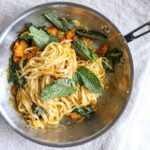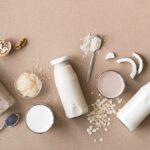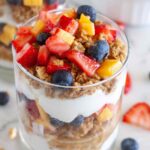Imagine a world where breakfast isn’t just fuel, but a vibrant explosion of flavor and energy, all without the dairy. This isn’t a restrictive diet; it’s a culinary adventure! “Start Your Day Dairy-Free: Recipes That Energize” unlocks the secrets to crafting delicious, dairy-free meals that power your mornings, fuel your afternoons, and leave you feeling vibrant from sunrise to sunset. Prepare to discover a world of creamy cashew sauces, hearty grain bowls, and invigorating smoothies, all designed to optimize your energy levels naturally.
This guide dives deep into the creation of dairy-free meals, offering a treasure trove of recipes categorized by mealtime—breakfast, lunch, dinner, and even snacks. We’ll explore the nutritional benefits of each recipe, highlighting the importance of macronutrient balance for sustained energy. Learn clever dairy-free substitutions, master flavor-enhancing techniques, and design a personalized meal plan tailored to your unique needs and preferences. Get ready to transform your relationship with food and unlock your peak performance!
Dairy-Free Breakfast Powerhouses

Kickstarting your day with a nutritious and energizing breakfast is crucial, especially when following a dairy-free diet. The right combination of macronutrients – complex carbohydrates, healthy fats, and lean protein – can provide sustained energy, preventing mid-morning slumps and boosting overall productivity. These recipes are designed to be both delicious and beneficial for your well-being.
Dairy-Free Breakfast Recipe Table
A variety of dairy-free breakfast options offer sustained energy throughout the morning. The following table provides a selection of recipes, highlighting key ingredients, preparation time, and the specific energy-boosting benefits each offers.
| Recipe Name | Key Ingredients | Preparation Time | Energy Boosting Benefits |
|---|---|---|---|
| Overnight Oats with Berries and Nuts | Rolled oats, almond milk, mixed berries, chia seeds, chopped almonds | 5 minutes prep, overnight soak | Sustained energy from complex carbs, fiber, and healthy fats; antioxidants from berries |
| Savory Tofu Scramble with Spinach and Mushrooms | Firm or extra-firm tofu, spinach, mushrooms, nutritional yeast, onion powder | 15 minutes | Protein from tofu keeps you full; iron and vitamins from spinach and mushrooms; satiety from fiber |
| Coconut Yogurt with Granola and Fruit | Coconut yogurt, homemade or store-bought granola, seasonal fruit (banana, mango, etc.) | 5 minutes | Probiotics from coconut yogurt aid digestion; fiber and complex carbs from granola; vitamins and minerals from fruit |
| Avocado Toast with Everything Bagel Seasoning | Whole-wheat toast, mashed avocado, everything bagel seasoning, red pepper flakes (optional) | 5 minutes | Healthy fats from avocado for sustained energy; fiber from whole-wheat toast; satisfying and flavorful |
| Smoothie with Spinach, Banana, and Almond Butter | Spinach, banana, almond milk, almond butter, protein powder (optional) | 5 minutes | Quick energy from banana; sustained energy from healthy fats in almond butter; protein and nutrients from spinach |
Infographic: Nutritional Breakdown of Dairy-Free Breakfasts
This infographic visually represents the nutritional benefits of each dairy-free breakfast recipe, emphasizing macronutrient breakdown and sustained energy release. Imagine a vibrant infographic, using a color scheme of greens, yellows, and oranges to represent different food groups and energy levels. Each recipe is represented by a circular segment, showing the proportional breakdown of carbohydrates (yellow), proteins (orange), and fats (green). A subtle upward-trending line within each segment visually indicates the sustained energy release throughout the morning. Small icons representing key vitamins and minerals are incorporated into each segment. The overall design is clean and modern, with clear, concise labels and data points. The title “Fuel Your Morning, Dairy-Free!” is prominently displayed at the top.
Step-by-Step Guide: Overnight Oats with Berries and Nuts
This recipe provides a simple yet nutritious way to start your day. The overnight soaking process allows the oats to soften and absorb the liquid, resulting in a creamy texture.
- Combine Ingredients: In a jar or container with a lid, combine ½ cup rolled oats, 1 cup almond milk (or other preferred dairy-free milk), 1 tablespoon chia seeds, and a pinch of cinnamon.
- Add Sweetness and Flavor: Stir in 1-2 tablespoons of maple syrup or honey (optional, depending on desired sweetness). You can also add a teaspoon of vanilla extract for enhanced flavor.
- Layer Berries and Nuts: Gently fold in ½ cup mixed berries (strawberries, blueberries, raspberries) and ¼ cup chopped almonds (or other nuts).
- Refrigerate Overnight: Cover the container tightly and refrigerate for at least 4 hours, or preferably overnight, to allow the oats to soften and the flavors to meld.
- Enjoy Cold: In the morning, give the oats a good stir. Enjoy cold straight from the refrigerator, or add a few more berries and nuts for extra toppings.
Dairy-Free Lunch & Snack Ideas for Energy
Maintaining energy levels throughout the day, especially without relying on dairy, requires careful planning of nutritious and portable lunches and snacks. Choosing foods rich in complex carbohydrates and healthy fats provides sustained energy release, preventing the mid-afternoon slump often associated with simple sugars. This section explores delicious and practical dairy-free lunch options perfect for work or school.
Dairy-Free Lunch Recipes
Three easy-to-prepare and pack dairy-free lunch recipes are presented below, each designed to provide sustained energy and satisfy hunger without relying on dairy products. These recipes are versatile and can be adapted to personal preferences and dietary needs.
1. Quinoa Salad with Roasted Vegetables and Chickpeas: This vibrant salad combines the protein-packed quinoa with roasted vegetables like bell peppers, zucchini, and red onion, adding a hearty dose of chickpeas for extra fiber and protein. A lemon-herb vinaigrette provides a zesty flavor and avoids creamy dairy-based dressings. Imagine the colorful medley of roasted vegetables, their slightly caramelized edges glistening, nestled amongst fluffy quinoa and plump chickpeas. The vibrant vinaigrette adds a refreshing burst of acidity, cutting through the richness of the other ingredients. This salad is easily packed in a reusable container and keeps well for several hours.
2. Lentil Soup with Whole-Wheat Bread: A warm and comforting lentil soup is a powerhouse of protein and fiber. Lentils provide sustained energy, while the whole-wheat bread adds complex carbohydrates for a balanced meal. Picture a steaming bowl of hearty lentil soup, the lentils tender yet holding their shape, the broth a rich, deep orange-brown hue. The aroma is warm and inviting, filled with the earthy scent of lentils and subtle spices. A slice of crusty whole-wheat bread complements the soup perfectly, soaking up the flavorful broth. This is a great option for colder days and can be easily transported in a thermos.
3. Avocado and Hummus Wrap with Sprouts: This quick and easy wrap provides healthy fats from avocado and hummus, along with fiber from sprouts and whole-wheat tortilla. The creamy avocado and earthy hummus create a delicious and satisfying filling, while the sprouts add a refreshing crunch. Visualize a soft whole-wheat tortilla enveloping a vibrant mixture: creamy green avocado slices, a swirl of beige hummus, and a scattering of bright green sprouts. The whole wrap is easily rolled and secured, ready for transport. This is a light yet filling option perfect for warmer days.
Nutritional Comparison of Dairy-Free Lunch Recipes
The following table compares the approximate nutritional profiles of the three dairy-free lunch recipes. Note that these values are estimates and can vary depending on specific ingredients and portion sizes.
| Recipe | Calories (approx.) | Protein (approx. grams) | Carbohydrates (approx. grams) | Fats (approx. grams) |
|---|---|---|---|---|
| Quinoa Salad | 450 | 15 | 60 | 15 |
| Lentil Soup | 380 | 20 | 50 | 10 |
| Avocado & Hummus Wrap | 400 | 12 | 45 | 20 |
Importance of Healthy Fats and Complex Carbohydrates
Incorporating healthy fats and complex carbohydrates into dairy-free lunches is crucial for sustained energy release. Healthy fats, such as those found in avocados, nuts, and seeds, provide a slow and steady release of energy, preventing energy crashes. Complex carbohydrates, like those in quinoa, lentils, and whole-wheat bread, are digested more slowly than simple sugars, providing a longer-lasting energy source. This combination ensures a stable energy supply throughout the afternoon, promoting focus and productivity.
A balanced intake of healthy fats and complex carbohydrates is key to avoiding energy fluctuations and maintaining sustained energy levels throughout the day.
Embarking on a dairy-free journey doesn’t mean sacrificing taste or energy; it simply means expanding your culinary horizons. “Start Your Day Dairy-Free: Recipes That Energize” has equipped you with the knowledge and recipes to create a vibrant, dairy-free lifestyle that nourishes your body and invigorates your spirit. From the creamy richness of cashew-based sauces to the satisfying heartiness of grain bowls, each recipe is a testament to the boundless possibilities of dairy-free cooking. Remember, the key is balance, mindful ingredient selection, and a dash of culinary creativity. So, step into your kitchen, experiment with these recipes, and discover the energizing power of dairy-free eating!
User Queries
What are the common allergens besides dairy found in these recipes?
While these recipes focus on being dairy-free, always check individual recipes for potential allergens like nuts, soy, or gluten. Ingredients can be easily substituted to accommodate various dietary restrictions.
Can I adapt these recipes for different dietary needs, such as gluten-free or vegan?
Many of these recipes are easily adaptable. Look for gluten-free alternatives for flours and grains, and ensure all ingredients align with your vegan requirements. Always check ingredient labels for hidden allergens.
How long can I store the prepared meals?
Storage times vary depending on the recipe. Generally, refrigerated leftovers should be consumed within 3-4 days. Always ensure proper refrigeration and observe any specific storage instructions provided in individual recipes.
Are these recipes suitable for athletes or those with high energy demands?
Yes, the emphasis on complex carbohydrates and healthy fats in these recipes makes them ideal for providing sustained energy for athletes and individuals with active lifestyles. Adjust portion sizes to meet individual caloric needs.


